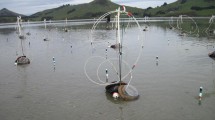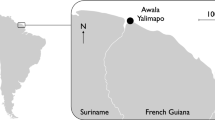Abstract
The quantitative development and uptake of radio-labelled phytodetritus in benthic macro- and meiofauna was studied in a 5-month experiment in two mesocosms, one of which received a single large nutrient (N and P) addition, while the other served as control. In reponse to the 12-fold increase in phytoplankton biomass noted after 2 weeks and the resulting enhanced accumulation of fresh phytodetritus, the abundance and biomass of the polychaetes Mediomastus ambiseta and Polydora ligni and the mud anemone Cerianthiopsis americanus increased significantly in the enriched tank. The abundances of P. ligni and M. ambiseta increased 37-fold and 12-fold, respectively, within the first two months of the experiment. No other macrofaunal or meiofaunal taxa showed any consistent positive quantitative response to the increased input of phytodetritus. In the control tank no considerable change in the benthic community structure was noted. The measurements of radio-label uptake within the benthic fauna showed that the quantitatively most successful species utilized fresh phytodetritus highly. However, a high degree of utilization of fresh detritus was also shown by taxa that did not respond quantitatively within the 5 month of the experiment, and almost all taxa showed a preference for fresh detritus over older organic material. Within the benthic meiofauna, kinorhynchs and especially foraminiferans showed a remarkably low preference for fresh detritus. A budget calculation comparing the total amounts of labelled organic carbon bound in animal tissue and in the sediment indicated that at any time at least 75% of this carbon was available for assimilation by deposit feeders. These results suggest that factors other than the availability of food, such as competition for space by a few opportunistic macrofauna species, limited the response of other species within this benthic community to the increased input of phytodetritus.
Similar content being viewed by others
References
Blake JA (1969) Reproduction and larval development of Polydora from northern New England (Polychaeta: Spionidae). Ophelia 7: 1–63
Cederwall H, Elmgren R (1980) Biomass increase of benthic macrofauna demonstrates eutrophication of the Baltic Sea. Ophelia Suppl 1: 287–304
Cederwall H, Elmgren R (1990) Biological effects of eutrophication in the Baltic Sea, particularly the coastal zone. Ambio 19: 109–112
Coull BC, Bell S (1979) Perspectives of marine meiofaunal ecology. In: Livingston RJ (ed) Ecological processes in coastal and marine systems. Plenum, New York, pp 189–216
Dauer DM, Maybury CA, Ewing RM (1981) Feeding behavior and general ecology of several spionid polychaetes from the Chesapeake Bay. J Exp Mar Biol Ecol 54: 21–38
Elmgren R (1973) Methods of sampling sublittoral soft bottom meiofauna. Oikos Suppl 15: 112–120
Fauchald K, Jumars PA (1979) The diet of worms: a study of polychaete feeding guilds. Oceanogr Mar Biol Annu Rev 17: 193–284
Frithsen JB, Rudnick DT, Elmgren R (1983) A new, flow-through corer for the sampling of surface sediments. Hydrobiologia 99: 75–79
Frithsen JB, Keller AA, Pilson MEQ (1985) Effects of inorganic nutrient additions in coastal areas: a mesocosm experiment data report, vol. 3 (MERL Series Report No 5). University of Rhode Island, Kingston
Frithsen JB, Rudnick DT, Doering PH (1986) The determination of fresh organic carbon weight from formaldehyde preserved macrofaunal samples. Hydrobiologia 133: 203–208
Grassle JF, Grassle JP (1974) Opportunistic life histories and genetic systems in marine benthic polychaetes. J Mar Res 32: 253–284
Grassle JF, Grassle JP, Brown-Leger LS, Petrecca RF, Copley NJ (1985) Subtidal macrobenthos of Narragansett Bay. Field and mesocosm studies of the effects of eutrophication and organic input on benthic populations. In: Gray JS, Christiansen ME (eds) Marine biology of polar regions and effects of stress on marine organisms. Wiley, Chichester, pp 421–434
Hannan CA (1984) Planktonic larvae may act like passive particles in turbulent near-bottom flows. Limnol Oceanogr 29: 1108–1115
Hartmann-Schröder G (1971) Polychaeta (Tierwelt Deutschlands, Teil 58). Gustav Fischer, Jena
Hicks GRF, Coull BC (1983) The ecology of marine meiobenthic harpacticoid copepods. Oceanogr Mar Biol Annu Rev 21: 67–175
Hinga KR, Pilson MEQ, Lee RF, Farrington JV, Tjessein K, Davis AC (1980) Biogeochemistry of benzanthracene in an enclosed marine ecosystem. Environ Sci Technol 14: 1136–1143
Holm-Hansen O, Lorenzen CJ, Holmes RW, Strickland JDH (1965) Fluorometric determination of chlorophyll. J Perm Cons Int Explor Mer 30: 3–15
Hunt CL, Smith DL (1983) Remobilization of metals from polluted marine sediments. Can J Fish Aquat Sci 40 (Suppl 2): 132–142
Jensen P (1983) Meiofaunal abundance and vertical zonation in a sublittoral soft bottom, with a test of the Haps corer. Mar Biol 74: 319–326
Levinton JS, Stewart S (1988) Effects of sediment organics, detrital input, and temperature on demography, production, and body size of a deposit feeder. Mar Ecol Prog Ser 49: 259–266
Lopez GR, Levinton JS (1987) Ecology of deposit feeding animals in marine sediments. Q Rev Biol 62: 235–260
Maughan JT (1986) Relationship between macrobenthic infauna and organic carbon. PhD Dissertation, University of Rhode Island, Kingston
Mills EL (1967) The biology of an ampeliscid amphipod crustacean sibling species pair. J Fish Res Bd Can 24: 305–355
Nixon SW, Oviatt CA, Frithsen JB, Sullivan B (1986) Nutrients and the productivity of estuarine and coastal marine ecosystems. J Limnol Soc Sth Afr 12: 43–71
Officer CB, Biggs RB, Taft JL, Cronin LE, Tyler MA, Boynton WR (1984) Chesapeake Bay anoxia: origin, development and significance. Science 223: 22–27
Oviatt CA, Keller AA, Sampou PA, Beatty LL (1986) Patterns of productivity during eutrophication: a mesocosm experiment. Mar Ecol Prog Ser 28: 69–80
Pilson MEQ (1985) Annual cycles of nutrients and chlorophyll in Narragansett Bay, Rhode Island. J Mar Res 43: 849–873
Pilson MEQ, Oviatt CA, Nixon SW (1980) Annual nutrient cycles in a marine microcosm. In: Giesy JP (ed) Microcosms in ecological research (Department of Energy Symposium Series 52, CONF-781101). National Technichal Information Service, Springfield, Virginia, pp 753–778
Rudnick DT (1984) Seasonality of community structure and carbon flow in Narragansett Bay sediments. PhD Dissertation, University of Rhode Island, Kingston
Rudnick DT (1989) Time lags between the deposition and the meiobenthic assimilation of phytodetritus. Mar Ecol Prog Ser 50: 231–240
Rudnick DT, Oviatt CA (1986) Seasonal lags between organic carbon deposition and mineralization in marine sediments. J Mar Res 44: 815–837
Rudnick DT, Elmgren R, Frithsen JB (1985) Meiofaunal prominence and benthic seasonality in a coastal marine ecosystem. Oecologia 67: 157–168
Sokal RR, Rohlf FJ (1981) Biometry. The principles and practice of statistics in biological research, 2nd edn. Freeman, San Fransisco
Strickland JDH, Parsons TR (1972) A practical handbock of seawater analysis. Bull Fish Res Bd Canada 167: 1–311
Sullivan BK, Ritacco PJ (1985) The response of dominant copepod species to food limitation in a coastal marine ecosystem. Arch Hydrobiol Beih 21: 407–418
Widbom B, Elmgren R (1988) Response of benthic meiofauna to nutrient enrichment of experimental marine ecosystems. Mar Ecol Prog Ser 42: 257–268
Woeller FH (1961) Liquid scintillation counting of 14CO2 with phenethylamine. Analyt Biochem 2: 508–511
Yingst JY (1978) Patterns of micro-and meiofaunal abundance in marine sediments, measured with the adenosine triphosphate assay. Mar Biol 47: 41–54
Author information
Authors and Affiliations
Rights and permissions
About this article
Cite this article
Widbom, B., Frithsen, J.B. Structuring factors in a marine soft bottom community during eutrophication—an experiment with radio-labelled phytodetritus. Oecologia 101, 156–168 (1995). https://doi.org/10.1007/BF00317279
Received:
Accepted:
Issue Date:
DOI: https://doi.org/10.1007/BF00317279




